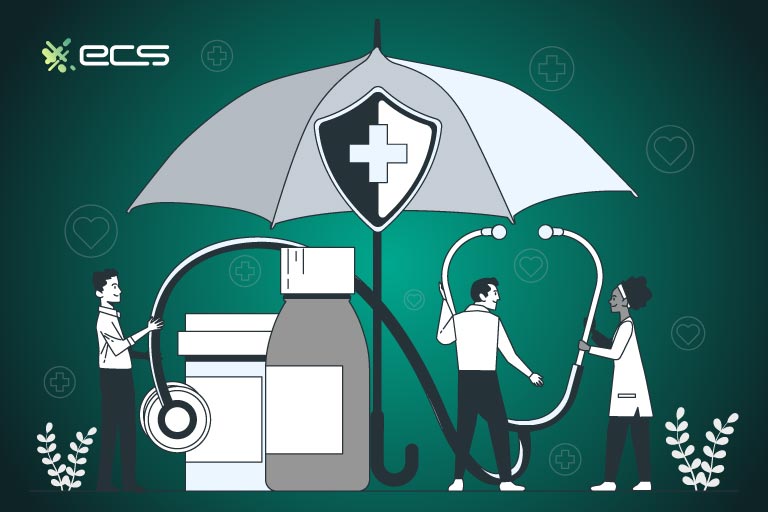Before discussing the latest payment trends, let’s look at a broad overview of the healthcare industry. Overall, the global healthcare industry is valued at $12 trillion. The domestic market is valued at more than $800 billion.
Around 65% of the revenue comes directly from patient care rather than “B2B” engagements (such as medical equipment providers selling to hospitals and doctor’s offices).
With all this money getting passed around, the question of healthcare payment processing will come up.
What Are Consumer Healthcare Trends in 2023?
While advances in medicine are due in part to research, many advances in the healthcare space are now tied to software and tech. Exciting developments are underway in a variety of areas. Although a foray into these topics would be fascinating, we will focus on the economic trends of the healthcare payment system.
Some of these trends may have implications in the payment landscape, which we will discuss. For example, wearable technology is often tied into a phone-based application, which may require a subscription.
Telehealth will require online payment gateways. Payment processing hardware for in-person retail clinics with high foot traffic volumes must leverage the most secure and sanguine healthcare payment technologies, like contactless payments.

The Trend For Primary Care Clinics Within Retail Settings
A typical visit to the doctor’s office may change in nature for millions of Americans—or disappear altogether. These visits may be increasingly replaced by retail clinics or telehealth (more on that in the next section). A retail clinic is a walk-in clinic located within a retail space…like a supermarket, big box store, department store, or shopping mall.
Retail clinics typically have shorter wait times and are less expensive (certainly out of pocket) than a hospital or a traditional doctor visit. They are not equipped to handle emergencies but common ailments like a cold or flu. Retail care is often a brand-name partnership rather than a small business venture.
For instance, Kaiser Permanente has partnered with Target to place retail clinics inside Target stores. And nationwide, 85% of these clinics are located within a CVS, Walgreens, or Kroger. The price of care at these clinics is as much as 80% lower than it would be in a hospital, making them affordable options for consumer patients.
Retail Clinics For Non-urgent Medical Attention
As recently as 2019, 8% of the U.S. population had no medical insurance (about 26 million people). For these individuals, getting non-urgent (but necessary) medical attention for routine ailments is cost-prohibitive.
A clinic offers these individuals an easy way to deal with a sore throat, headache, or chills. For some patients, a retail clinic makes them aware of a condition that might require further follow-up, such as hypertension or low blood sugar.
Retail clinic visits increased dramatically during the COVID-19 pandemic by 51%, more than other modalities of provider-patient interaction. For instance, emergency room visits decreased during this time by 15%. Urgent care centers increased by 14%. Telehealth visits surprisingly decreased by as much as 76%.
One of the biggest reasons retail clinics increased was for things like COVID testing. Telehealth visits cannot facilitate COVID testing, and they are unnecessarily expensive in the ER.
High Traffic, Lots Of Payments, And No Touching…Please
92% of Consumers cite convenience as a primary motivator for choosing retail clinics, followed by accessibility and cost. It makes sense, considering the average wait time for a family medicine appointment is 21 days. Meanwhile, a clinic can offer walk-in hours, even on weekends. Insurance companies also have a vested interest in pushing consumers towards these clinics since their treatment costs are lower.
A retail clinic should be equipped to process medical insurance. However, not all walk-in patients are going to have coverage. And even the ones that do will likely still have co-pays. There will be a high volume of patients, especially as retail clinics increase in popularity and cultural acceptance. Not to mention insurers steering patients there.
Patient-consumers visiting a clinic will likely be more conscientious of airborne and tactile transfer of illnesses. As such, they will appreciate contactless payment technology such as mobile payments, contactless cards, and QR codes (more on that later).
The Trend Towards Telehealth Visits
Another trend in healthcare is telehealth. Surprisingly (as cited), telehealth declined during the pandemic. However, when considering the fact that the patient-caregiver relationship is (at least supposed to be) at the core of medicine, this fact is not surprising. Some patients want to meet with a doctor in person to discuss sensitive topics. They may also feel that telehealth visits do not facilitate clear and easy communication.
The jury seems to still be out on telehealth. However, investment in the space portrays a sentiment of optimism among investors, with investments reaching a record $5 billion in Q2 of 2021. Moreover, the long-term perspective on the telehealth industry is positive. The domestic telehealth market size was estimated at nearly $30 billion in 2022 and will grow through 2030 at a CAGR of 22.9%.
Upward trends in telehealth may prove to be motivated by an upcoming shortage of physicians. The Association of American Medical Colleges estimates that there may be as many as 124,000 physicians “missing” from the workforce by 2034. Telehealth may bridge the gap between patients needing care and available physicians—by connecting them remotely and allowing physicians to see more patients.
Remote medicine will require remote payment solutions, specifically online payment gateways. Patients paying out of pocket or making co-pays need an online portal that takes debit and credit cards and ACH payments.
The medical payment data exchanged as card-not-present (CNP) transactions will necessitate additional anti-fraud measures. Any payment data stored by the medical practice will need protective walls against data theft.

Preventative Care and Wellness
Another healthcare trend is wellness products and programs. “Wellness” is maintaining a healthy lifestyle so that acute care is not needed. The global wellness economy was valued at $4.4 trillion in 2020. Its largest sectors were:
- Personal care ($955 billion).
- Nutrition and weight loss ($945 billion).
- Exercise ($738 billion).
- Wellness tourism ($436 billion).
- Traditional medicinal practices ($413 billion) which may include things like Traditional Chinese Medicine and yoga.
That’s right—a group travel package that involves biking through the mountains of France while living off juices and smoothies is part of the general healthcare landscape. 79% of polled consumers believe wellness is essential, and 42% prioritize it. Nearly 50% of polled American consumers say they’ve increased their wellness spending over the last three years.
Wellness companies are combining medicine, software, and hardware for innovative products and services. The largest and most branded companies include names like FitBit, Peloton, and WeightWatchers.
But they also include companies like Johnson & Johnson, Virgin, and Intuit. These companies are entering the wellness space because it’s an increasing market with a steady stream of engaged consumers.
At this time, most health insurance policies don’t cover the majority of wellness products and services. Health insurance does not cover a subscription to Peloton or WeightWatchers, for instance. Nor does it cover things like vitamins and supplements. Consumers are paying for these products out of pocket.
Therefore, companies in the wellness space will need healthcare payment solutions. Many of these companies will specifically benefit from payment services that provide a subscription as part of the customer experience. Before going into this particular healthcare payment trend, let’s discuss one more related area: hardware.
Wearable Technology
Americans are using smartwatches, for instance, to monitor various healthcare-related conditions. Nearly 60% of consumers are monitoring how many steps they take each day. 42% are monitoring workout performance. 37% are monitoring cardiovascular health. 35% monitor sleep quality. 32% monitor calorie intake. 17% monitor stress levels. 11% monitor possible Covid symptoms. 8% monitor a chronic condition.
More than 440 million global patients will be wearing health and wellness wearables by the end of 2023. This usage has tied into a broader context of using big data and analytics to make informed decisions. While one typically thinks of large corporations using data to make decisions, consumers also use it to make healthier choices (such as with calorie counting) or become aware of conditions they did not know about (such as interrupted sleep).
Many of these wearable devices are tied into applications. These applications are often a subscription business model. The subscription business model means that customers provide payment information one time, which is charged on a recurring basis (such as annually or monthly). Like wellness products and services, wearables may require a recurring payment to keep the B2C relationship going.

Subscription Solutions For Healthcare Payments
American consumers, in particular, love subscriptions, consuming 53% of a global $1.5 trillion industry. The average millennial has 17 subscriptions, and the average consumer (millennials included) is spending $273 on subscriptions monthly.
The most popular subscription types are streaming services like Netflix (98% of consumers), but health and fitness are also very popular, with 34% of consumers subscribed to something wellness-related. Another 31% are subscribed to something food-related, some of which may involve “health and wellness” related foods.
Subscription-based businesses have particular needs around their billing processes. They must securely store customer card and bank account information, protecting it from data theft and fraud. Doing this according to the standards set forth by Mastercard and Visa is cost-prohibitive for most small to midsize business owners.
The best solution is often to outsource the processing of subscription payments to a payment processor. The healthcare payment processing company will have the resources to store customer payment information remotely, securely, and according to the standards that financial institutions (like banks and card networks) require.
Cannabis and High-Risk Healthcare Payment Processing
Another exciting trend in medicine is the cannabis industry. While long regarded as a “purely recreational drug” in mainstream society, contemporary research confirms what traditional medicinal practitioners have known for ages: cannabis and cannabinoids are wonderdrugs for treating physical and mental ailments. Research is showing their usefulness in managing chronic pain, anxiety, PTSD, and even diseases like Alzheimer’s.
But despite the recent entry of cannabis into “establishment” medical practice, there is still a long way to go in terms of medical and health care payments. The payments industry is very weary of industries that have just crossed the cusp of legality.
They are also wary of products that reside in a diverse legal and regulatory landscape because it can create complications in facilitating payments between customers, business owners, and financial institutions.
A perfect example of this is marijuana. While it is now recreationally legal in 23 states and medically legal in 38 states, exact laws vary widely within these states. In some states, a dispensary owner can deliver cannabis to customers. In some states, they can even grow cannabis for their patients. Then, there are rules about how much marijuana patients can possess at one time.
The upshot of this variegated legal landscape and the recent legality of marijuana is that businesses engaged in “cannabis wellness” will probably need alternative payment solutions. Simple solutions like Square, Shopify, and Stripe will not work.
Cannabis businesses will need a high-risk merchant account payment processor to collect payments. These types of “healthcare” payment processors work with businesses in so-called high-risk industries. They can work out fee structures and safety measures like a rolling reserve to service customers who need to collect payments.

Mental Health
Mental health is part of healthcare as well. As mentioned, patient trends have moved away from the initial excitement of telehealth. The COVID-19 Pandemic forced many consumer patients to engage with care providers through a screen.
It may also have driven some consumers to seek mental health help for the first time. Pandemic-related stress, for instance, may have contributed to a 25% increase (or more) in cases of anxiety or depression.
Consumers were anxious about their physical health and the health of their loved ones. Meanwhile, lockdowns, quarantines, and isolation exacerbated social issues and in-home tensions.
But the pandemic is (or seems to be) over now, and some are arguing that the telehealth bubble will go the way of the dot-com bubble (popping). Others argue that the mental health application space is booming and will remain strong despite recent cooldowns.
Either way, mental health applications are probably here to stay, just like telehealth. The advent of AI is only increasing this trend. Tech startups like Woebot, Wysa, and Happify are essentially using robots to help patients with their problems.
AI may prove to be more effective than a Ph.D. playing tic-tac-toe while patients delve into childhood memories. The military already uses AI therapists to help veterans process PTSD, with some quantifiable success.
In any case, these virtual care mental health apps will face various payment issues. One is similar to the issue that cannabis providers face: a diverse regulatory landscape. Providing mental health services across state lines is a tricky game regarding legality. Then, there is also the issue of providing customers with online payment options and storing data securely for their healthcare payments.
And for some patients, there is also the issue of insurance, which brings us to our next point.
Medical Billing Trends in 2023
Some businesses in the healthcare industry need to be able to take insurance to survive. Others do not want to take insurance, as it limits how much they can make (an example would be therapists who only take out-of-pocket patients). Setting aside businesses that don’t take insurance, let’s look at the ones that do.
The insurance landscape increases the complexity of collecting payments for such a business. For starters, a business must be paneled with an insurance company to accept patients with that insurance.
In treating patients, the care provider must classify the nature of illness or disorder along the ICD-11 (the most recent generation of the International Classification of Diseases). There are 55,000 different codes in this latest paradigm set forth by the World Health Organization, in contrast to the 14,000 of ICD-10.
Then, there is the issue of charging the patient and the insurance company. There may be some required remittance that one party will send to another to balance out the financial obligations. Usually, the remittance is sent by the insurer to the healthcare provider to cover the cost of care. Occasionally, it is sent to a patient directly if they have overcompensated for their healthcare payments.
How Does Medical Billing Work For Healthcare Payments?
In broad strokes, the care provider will send an 837 or an EDI to the insurance company, outlining the nature of the care provided and its costs. The insurance company will receive this and send back an 835 ERA, which lists their interpretation of the care provided and its related costs.
As this process unfolds, the clearinghouse of the payer (the insurance company) will facilitate payment into the payee’s account (the care provider). If payments are sent to the wrong account or botched, it can take hundreds of hours to untangle the accounting mess. Healthcare Payments are also often made in one lump sum, so it is impossible to untangle details about specific care visits from the deposit itself.
This information must be found in the 835 ERA, which the insurer sends back to the care provider. And as mentioned, this 835 ERA may contain adjustments from the insurer about what they are or aren’t willing to cover. As such, the 835 ERA may not match up with the 837 that was sent to them.
To make matters more interesting, the entire process is not a real-time payment but may take weeks to facilitate. By the time a deposit is received, care providers may have no idea if they are receiving everything they want to be paid for.
Third-Party Billing
As a result, many healthcare providers outsource the billing to a third party. If they had to do it themselves, they would have no time to provide patient care.
Healthcare providers need to work with payment processors who can handle things like remittance payments and the financial institutions that provide banking services to the payer (the insurance companies).
There may be some occasional backtracking, adjustments, and accounting safaris involved. As such, a payment processor will need to be able to assist in correcting occasional mistakes or billing-related complications.
This need effectively rules out large, hands-off payment aggregators like Square, Stripe, or PayPal. A hands-on, involved approach is more needed, especially for something as potentially complicated as the insurance landscape.
American Debt As it Relates to Healthcare
American consumers are—more likely than not—unable to meet emergency-related financial obligations. As many as 66% of Americans could not meet a surprise $400 expense with their own cash reserves. And while some of them can turn to credit cards, a personal loan, or a HELOC as a solution, many cannot.
A 2019 Experian survey found that the average consumer had an outstanding credit card balance of $6,194. After a global pandemic, inflation, and the looming specter of recession, the average consumer is now looking at $7,279 in unpaid balances.
This 17% increase in credit card debt does not exist in a vacuum but also accompanies mortgage debt, car loans, and the ever-swelling balloon of student debt. The average American is carrying a $20,987 auto loan, $220,380 home loan, and $39,487 student loan, according to the now-defunct First Republic Bank—which says something about the whole affair if you can Chase the allusion.
In the context of all unpaid debts, First Republic (citing the Federal Reserve) also states that an American household’s average resultant debt-to-income ratio is a whopping 145%. To explain with an example, a household making a comfortable six figures would have about $145,000 in unpaid debts.
Inflation Makes Matters Worse
The rising cost of living has further complicated the picture of this debt. About 71% of Americans are concerned about paying for gas, 50% are concerned about paying for utilities, and 47% for food. Now on to healthcare-related expenses: 58% are worried about paying surprise medical bills, 45% about long-term care for a family member, 44% about health insurance deductibles, and 43% about prescription drugs.
In actuality, consumer sentiments are reflecting the climate of inflation. General inflation (according to the same survey) increased by 8.85% in 2022, for instance. And while healthcare-related inflation increased by a lesser 4.8%, that is still a substantial, anxiety-inducing increase.
There is probably no need to continue beating a dead horse here, as they say. The average American is poorly equipped to deal with the financial fallout of emergencies in general, including medical-related emergencies. And even if they still have recourse to paying for it, the idea of how they’ll pay still gives them anxiety.

Buy Now Pay Later (BNPL)
Buy Now, Pay Later is where a payment plan comes into play. Many retailers are incorporating BNPL (buy now, pay later) technology at the point of sale. The BNPL option is different from using a credit card because BNPL does not charge the customer interest (usually).
Companies like Klarna, Affirm, and Afterpay allow consumers to make a purchase and split it into 4-12 installments with no additional interest or an origination fee.
Of course, someone will pay for this, and it’s the merchant. Merchants will pay as much as 6% of a sale to offer BNPL options at checkout, which is substantially higher than the 2-3% charged by card networks.
Weighing the pros and cons, many merchants opt for these integrations because they feel that this flexibility will ultimately increase their revenue.
Buy Now Pay Later (BNPL) as It Relates To Healthcare
But what does retail have to do with healthcare? In fact, BNPL technology is probably even more apropos to health and wellness. Using Klarna, Affirm, or Afterpay to make a discretionary purchase (like furniture, clothes, or whatever else) differs from paying a medical bill. Medical care is nearer and dearer to consumer interests—literally, as it involves the care of their body.
Of course, some procedures are elective. However, many elective procedures can potentially increase the patient’s sense of well-being or happiness. And yet, most consumers cannot afford an elective procedure. Once again, this is where BNPL comes into play.
Whether surgery or a procedure is elective or necessary (and not covered by insurance, or the patient is uninsured), paying in installments can make it possible for the patient to get the care they need.
Working with a payment processor who can facilitate BNPL will open your care up to patients who would otherwise be unable to pay. Moreover, the payment processor will likely be able to work out better fees than the 6% charged by big fintech companies.
Contactless Payment Solutions
Finally, it’s time to bring it all home by discussing contactless payment solutions. Everyone knows that the doctor’s office is (ironically) a great place to contact germs. Traditional payment methods involve a lot of touching—like handing over cards, touching keypads, and holding pens to sign a screen.
Patients may be concerned about the hygiene of such practices, especially after the COVID-19 pandemic. Contactless payment technology can eliminate magnetic card swipes and even PIN inputs.
Customers can hold a contactless card or even their mobile phone up to a terminal to complete a payment in seconds. Radio waves facilitate these contactless payments, and the information passed around is tokenized to prevent fraud.
Implementing contactless healthcare payments means having the right hardware. Another hardwareless solution is QR codes. Patients on their smartphones can scan these codes. They will then be directed to a payment page online, where they can complete their payment. QR codes can also be placed on paperwork like bills: it’s the ultimate contactless form of payment for in-person visits.
That’s all for a discussion of payments and the healthcare system as they stand now. To learn more about these fascinating developments and how they could benefit your practice, call or contact us using the form below.
